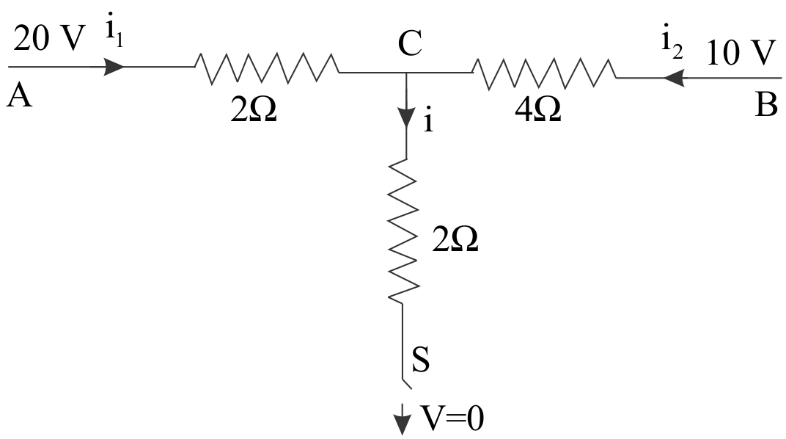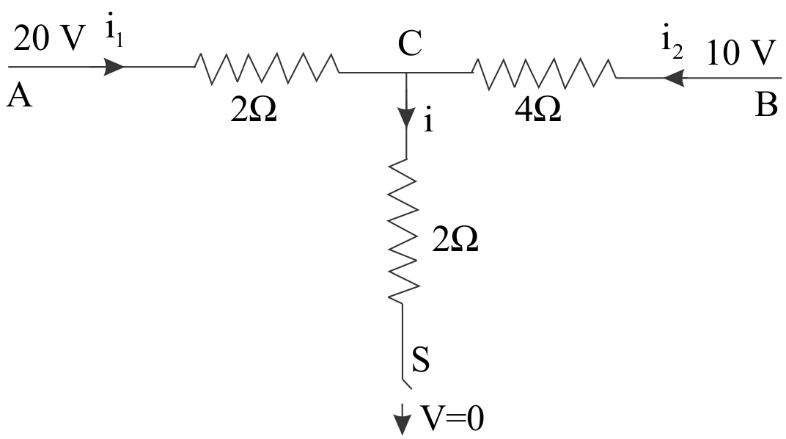
When the switch \[S\] , in the circuit shows, is closed, then the value of current \[i\] will be:

(A) \[3A\]
(B) \[5A\]
(C) \[4A\]
(D) \[2A\]
Answer
124.8k+ views
Hint: Let the potential across terminal C be \[xV\] and apply the Kirchoff’s Current Law at point C i.e. the current incoming is equal to the current outgoing . And first find the value of \[x\] and this will ultimately help us in finding the value of \[i\] .
Complete step by step solution:

One end of the terminal C is grounded as we can clearly see and it has a potential of zero volts. As soon as the switch is closed the current will start running in that arm and we are required to find that value .
Let the potential at point C be \[xV\] .
At point C , we will apply Kirchoff’s First Law or we can say Kirchoff’s Current law which states that: the sum of currents entering the junction is equal to the sum of currents leaving the junction . It is based on the principle of conservation of charge.
This means that: \[i = {i_1} + {i_2}\] ……..(i)
We know from Ohm’s Law that -
\[
current = \dfrac{{voltage}}{
resistor \\
\\
} \\
i = \dfrac{V}{R} \\
\]
Writing the respective values of \[i,{i_1},{i_2}\] in eq(i) in terms of voltage and resistance across them .
\[
i = {i_1} + {i_2} \\
\dfrac{{x - 0}}{2} = \dfrac{{20 - x}}{2} + \dfrac{{10 - x}}{4} \\
2x = (40 - 2x) + (10 - x) \\
2x + 2x + x = 50 \\
5x = 50 \\
x = 10V \\
\]
Now we know that-
\[
i = \dfrac{{x - 0}}{2} \\
i = \dfrac{{10}}{2} \\
i = 5A \\
\]
Hence, the correct option is B.
Note: We have to keep in mind that we have taken $x$ as the potential across C and not potential drop ( which is the difference in potential between two points) while in the ohm’s law we always take potential difference across any two terminals . So that is why while writing the values of current we have written potential differences.
Complete step by step solution:

One end of the terminal C is grounded as we can clearly see and it has a potential of zero volts. As soon as the switch is closed the current will start running in that arm and we are required to find that value .
Let the potential at point C be \[xV\] .
At point C , we will apply Kirchoff’s First Law or we can say Kirchoff’s Current law which states that: the sum of currents entering the junction is equal to the sum of currents leaving the junction . It is based on the principle of conservation of charge.
This means that: \[i = {i_1} + {i_2}\] ……..(i)
We know from Ohm’s Law that -
\[
current = \dfrac{{voltage}}{
resistor \\
\\
} \\
i = \dfrac{V}{R} \\
\]
Writing the respective values of \[i,{i_1},{i_2}\] in eq(i) in terms of voltage and resistance across them .
\[
i = {i_1} + {i_2} \\
\dfrac{{x - 0}}{2} = \dfrac{{20 - x}}{2} + \dfrac{{10 - x}}{4} \\
2x = (40 - 2x) + (10 - x) \\
2x + 2x + x = 50 \\
5x = 50 \\
x = 10V \\
\]
Now we know that-
\[
i = \dfrac{{x - 0}}{2} \\
i = \dfrac{{10}}{2} \\
i = 5A \\
\]
Hence, the correct option is B.
Note: We have to keep in mind that we have taken $x$ as the potential across C and not potential drop ( which is the difference in potential between two points) while in the ohm’s law we always take potential difference across any two terminals . So that is why while writing the values of current we have written potential differences.
Recently Updated Pages
Young's Double Slit Experiment Step by Step Derivation

Difference Between Circuit Switching and Packet Switching

Difference Between Mass and Weight

JEE Main Participating Colleges 2024 - A Complete List of Top Colleges

JEE Main Maths Paper Pattern 2025 – Marking, Sections & Tips

Sign up for JEE Main 2025 Live Classes - Vedantu

Trending doubts
JEE Main 2025 Session 2: Application Form (Out), Exam Dates (Released), Eligibility & More

JEE Main Exam Marking Scheme: Detailed Breakdown of Marks and Negative Marking

The formula of the kinetic mass of a photon is Where class 12 physics JEE_Main

JEE Main 2023 January 24 Shift 2 Question Paper with Answer Keys & Solutions

Learn About Angle Of Deviation In Prism: JEE Main Physics 2025

JEE Main 2025: Conversion of Galvanometer Into Ammeter And Voltmeter in Physics

Other Pages
JEE Advanced Marks vs Ranks 2025: Understanding Category-wise Qualifying Marks and Previous Year Cut-offs

JEE Main Login 2045: Step-by-Step Instructions and Details

Dual Nature of Radiation and Matter Class 12 Notes: CBSE Physics Chapter 11

Electric field due to uniformly charged sphere class 12 physics JEE_Main

Ideal and Non-Ideal Solutions Raoult's Law - JEE

JEE Mains 2025 Correction Window Date (Out) – Check Procedure and Fees Here!




